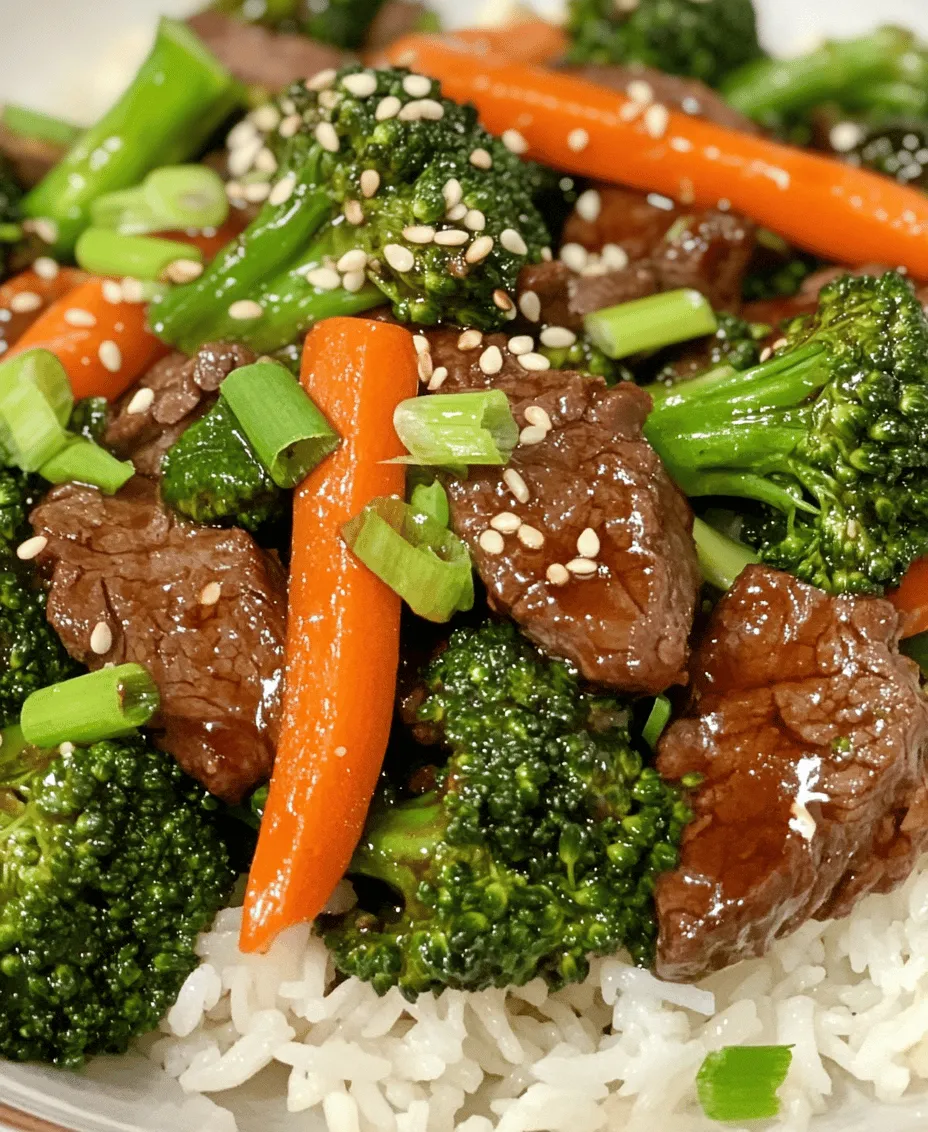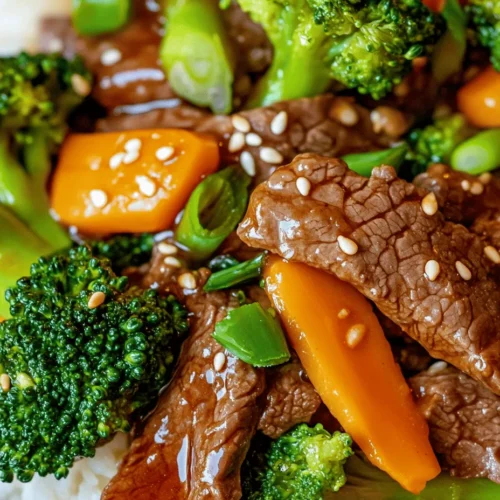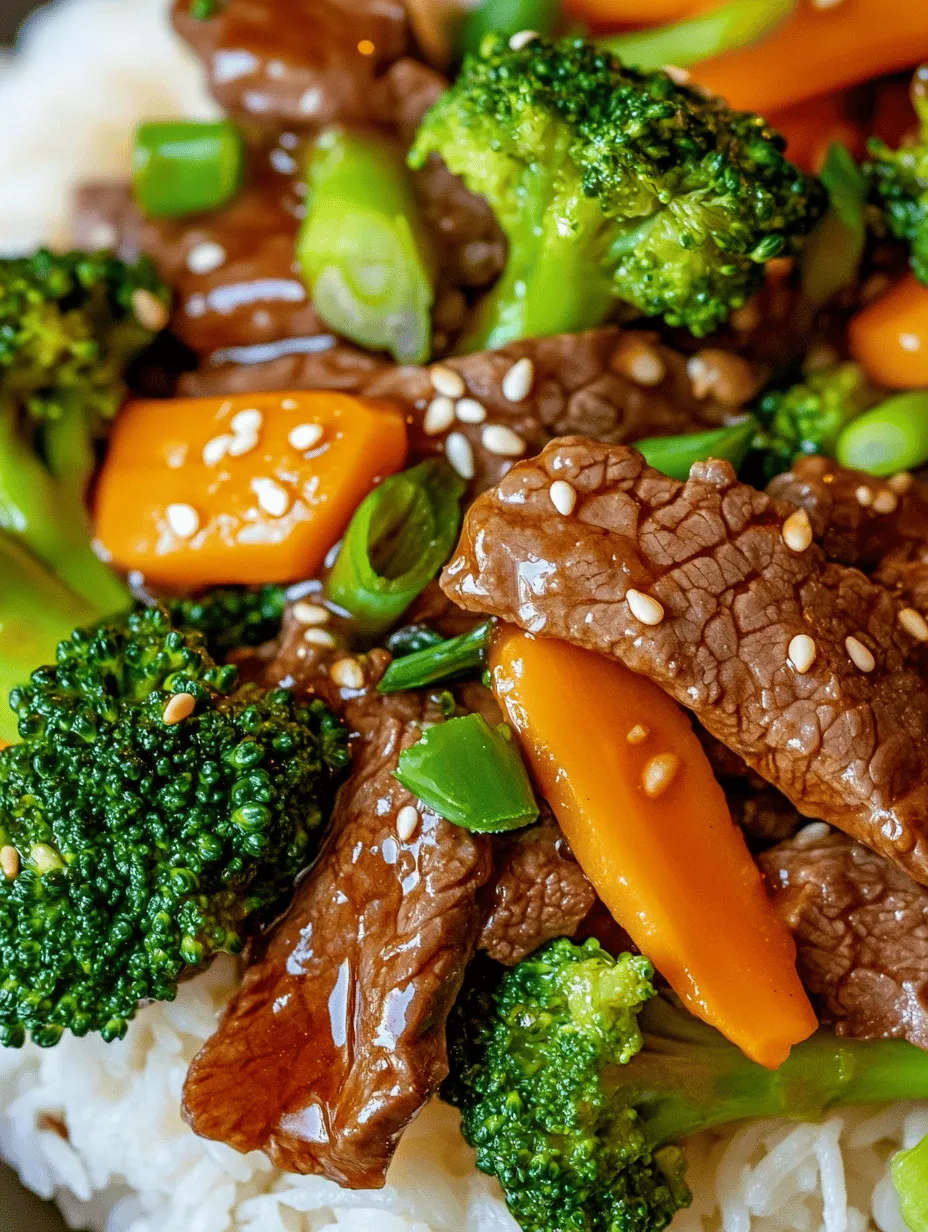Introduction
Classic Chinese Beef and Broccoli is a beloved dish that has earned its place in the hearts—and stomachs—of food lovers around the globe. Known for its savory flavors and vibrant colors, this dish beautifully showcases the harmony of tender beef and crisp broccoli, enhanced by a rich sauce that brings it all together. Rooted deeply in the culinary traditions of Chinese cuisine, Beef and Broccoli is often featured in restaurants as a staple dish, highlighting the balance between protein and vegetables that is central to many classic Chinese meals.
The dish has transcended its origins to become a popular choice in home kitchens as well. Its ease of preparation and the quick cooking time make it a favorite among busy families and culinary enthusiasts alike. Whether served over steamed jasmine rice or alongside noodles, this dish is not just a meal; it’s an experience of flavors and textures that captures the essence of Chinese cooking. In this article, we will guide you through a classic, easy-to-follow version of Beef and Broccoli that captures the authentic flavors of the dish while making it accessible for home cooks.
Understanding the Ingredients
To create the perfect Classic Chinese Beef and Broccoli, understanding the ingredients is key. Each component plays a vital role in achieving the dish’s signature taste and texture.
Flank Steak
When it comes to beef, choosing the right cut is crucial for tenderness and flavor. Flank steak is an excellent choice for Beef and Broccoli due to its lean nature and bold flavor. It is a long, flat cut of meat taken from the abdominal muscles of the cow, making it ideal for quick cooking methods like stir-frying. To ensure optimal tenderness, it’s important to slice flank steak against the grain, which helps break down the muscle fibers and results in a more enjoyable eating experience.
Broccoli
Broccoli not only adds a vibrant green color to the dish but is also packed with nutritional benefits. This cruciferous vegetable is high in vitamins C and K, fiber, and antioxidants, making it a healthy addition to any meal. The slight bitterness of broccoli pairs wonderfully with the savory flavors of the beef and sauce, creating a balanced dish that satisfies both the palate and nutritional needs.
Carrots
While broccoli is the star of the vegetable lineup, carrots play a supporting role by adding a pop of color and a touch of natural sweetness. Their crunch complements the tenderness of the beef and the crispness of the broccoli, creating a delightful texture contrast that enhances the overall eating experience. Carrots are also a great source of beta-carotene, which is converted into vitamin A in the body, contributing to good vision and immune function.
Soy Sauce and Oyster Sauce
The heart of any great stir-fry lies in its sauce, and for Beef and Broccoli, soy sauce and oyster sauce are essential. Soy sauce provides a salty umami flavor that enhances the savory notes of the beef. It is made from fermented soybeans and adds depth to the dish. On the other hand, oyster sauce contributes a unique sweetness and richness that complements the other ingredients. Made from oyster extracts, this sauce is a staple in Chinese cuisine, known for its ability to elevate the flavors of stir-fried dishes.
Sesame Oil
A key ingredient that elevates the flavor profile of Beef and Broccoli is sesame oil. This oil is made from toasted sesame seeds and has a distinct, nutty aroma. Just a few drops of sesame oil can transform a dish, adding an aromatic quality that enhances the overall sensory experience. It’s often used as a finishing touch, drizzled over the dish just before serving to infuse the meal with its rich flavor.
Fresh Garlic and Ginger
No Chinese dish is complete without the aromatic qualities of fresh garlic and ginger. These ingredients are essential for building flavor in Beef and Broccoli. Garlic adds a pungent, savory note, while ginger contributes warmth and a hint of sweetness. Together, they create a fragrant base that enhances the dish and rounds out its flavor profile. Using fresh garlic and ginger instead of powdered versions ensures maximum flavor and authenticity.
Marinating the Beef
Marinating the beef is a crucial step that enhances the flavor and tenderness of the flank steak. To create a simple yet effective marinade, you will need the following ingredients:
– 2 tablespoons soy sauce
– 1 tablespoon oyster sauce
– 1 teaspoon cornstarch
– 1 teaspoon sesame oil
– A pinch of black pepper
Step-by-Step Guide to Marinating Flank Steak
1. Prepare the Marinade: In a mixing bowl, combine the soy sauce, oyster sauce, cornstarch, sesame oil, and black pepper. Whisk the ingredients together until they are well blended.
2. Slice the Flank Steak: Place the flank steak on a cutting board and use a sharp knife to slice it against the grain into thin strips, about 1/4 inch thick. This technique helps to break down the muscle fibers and ensures each piece is tender.
3. Coat the Beef: Add the sliced beef to the marinade, ensuring that all pieces are evenly coated. Use your hands to massage the marinade into the meat to enhance flavor absorption.
4. Marinating Time: Cover the bowl with plastic wrap and let the beef marinate in the refrigerator. For optimal flavor, aim for at least 30 minutes to 1 hour. If time allows, marinating for up to 4 hours can yield even better results. However, avoid marinating for too long, as the soy sauce can begin to cure the meat and alter its texture.
5. Preparation for Cooking: Once the marinating time is complete, remove the beef from the refrigerator and let it sit at room temperature for about 15 minutes before cooking. This helps the meat cook more evenly.
The Role of Cornstarch
Cornstarch is a key ingredient in the marinade as it serves multiple purposes. First, it helps to tenderize the meat, creating a velvety texture that is characteristic of restaurant-quality stir-fries. Additionally, cornstarch forms a protective barrier around the beef during cooking, ensuring that the juices remain locked in, resulting in a succulent final dish.
Cooking Techniques
Cooking Beef and Broccoli primarily involves stir-frying, a technique that exemplifies the essence of Chinese cuisine. This method allows for quick cooking at high heat, ensuring that the ingredients retain their nutrients and vibrant colors.
Overview of Stir-Frying
Stir-frying is a cooking technique that involves cooking food quickly over high heat in a small amount of oil, often using a wok or a skillet. The high temperature allows the ingredients to cook rapidly while locking in their flavors and textures. This method is perfect for dishes like Beef and Broccoli, where you want the beef to be tender and the vegetables to remain crisp.
Benefits of High-Heat Cooking
Stir-frying at high heat has several benefits. First, it helps to sear the beef quickly, creating a beautiful caramelized exterior that adds depth to the flavor. Additionally, the high temperature prevents the vegetables from becoming too soft, allowing them to retain their crunch and nutritional value. This technique also enhances the Maillard reaction, a chemical reaction that occurs when proteins and sugars are exposed to heat, resulting in complex flavors and aromas.
Equipment Needed
For the best results, a wok is the ideal tool for stir-frying. The shape of a wok allows for even heat distribution and provides ample space for tossing ingredients. If you don’t have a wok, a large skillet can also work well. Ensure that your cookware is made from materials like carbon steel or stainless steel, as these materials can withstand high temperatures and promote effective searing.
Tips for Achieving the Perfect Sear on the Beef
To achieve the perfect sear on the beef, follow these tips:
1. Preheat the Pan: Ensure that your wok or skillet is preheated over medium-high heat before adding oil. A hot pan is essential for creating a good sear.
2. Use the Right Amount of Oil: Add a small amount of high-smoke-point oil, such as vegetable oil or canola oil, to the pan. This will help prevent sticking and promote browning.
3. Don’t Overcrowd the Pan: When cooking the beef, work in batches if necessary. Overcrowding the pan can cause the temperature to drop, resulting in steaming rather than searing.
4. Let the Beef Cook Undisturbed: Once the beef is added to the pan, allow it to cook undisturbed for a minute or two to develop a sear before stirring.
5. Cook Until Just Done: Flank steak cooks quickly, so keep an eye on it and remove it from the pan as soon as it is no longer pink in the center. This will ensure that the beef remains tender and juicy.
Preparing the Vegetables
As you prepare to cook your Beef and Broccoli, it’s essential to ensure that your vegetables are ready to go. Proper preparation not only enhances the cooking process but also contributes to the overall presentation of the dish.
Cutting the Broccoli
Begin by washing the broccoli thoroughly under cold water to remove any dirt or impurities. Cut the broccoli into bite-sized florets, ensuring that they are uniform in size for even cooking. Additionally, you can slice the stalks into thin pieces, as they are tender and flavorful, and should not go to waste.
Slicing the Carrots
Peel the carrots and slice them into thin rounds or julienne strips. This will allow them to cook quickly and integrate with the other ingredients. Thinly sliced carrots not only add sweetness but also provide a beautiful contrast in color against the green broccoli.
Preparing Garlic and Ginger
Mince fresh garlic and ginger to release their aromatic qualities. For optimal flavor, consider using a microplane or a sharp knife to finely chop them. When ready to cook, having these aromatics prepped will ensure they can be added quickly to the hot pan without burning.
With all your ingredients prepped and ready, you’ll be set to move on to the cooking process, where the magic of combining these components will come to life. Stay tuned for the next part of our recipe, where we’ll dive into the actual cooking steps and bring your Classic Chinese Beef and Broccoli to life in your kitchen.

Importance of Vegetable Preparation
When preparing Classic Chinese Beef and Broccoli, the way you cut and prepare your vegetables plays a crucial role in the overall success of the dish. The goal is to ensure that all components cook uniformly, allowing for an even texture and flavor throughout.
Cutting Techniques for Uniform Cooking
Broccoli florets should be cut into bite-sized pieces, ensuring that they are consistent in size. This uniformity allows them to cook evenly and maintain a delightful crunch. The stems of the broccoli can also be utilized; simply peel the outer layer and slice them into thin rounds, which will cook just as quickly as the florets.
For bell peppers, if you choose to include them, a julienne cut will work best, allowing them to blend seamlessly with the beef. Carrots, if used, should be thinly sliced or julienned to ensure rapid cooking. The key is to use a sharp knife and a steady hand, which will not only enhance the dish’s presentation but also ensure that every vegetable is perfectly tender.
Timing for Adding Vegetables to Maintain Their Crispness and Vibrant Colors
Timing is critical when it comes to adding vegetables. To maintain their crispness and vibrant colors, add the vegetables to the pan in stages. Start with the broccoli, as it requires a bit longer to cook. After a minute or so, introduce any other vegetables like bell peppers or carrots. This staggered approach ensures that each vegetable retains its unique texture and flavor, providing a delightful contrast when you take a bite.
Balancing Flavors: How to Ensure Vegetables Complement the Beef
The vegetables in this dish should not only add color but also enhance the flavors of the beef. A great way to balance flavors is to use aromatics such as garlic and ginger. Adding minced garlic and ginger to the oil before introducing the vegetables will infuse the oil with flavor, allowing it to coat the vegetables evenly. This technique ensures that each component of the dish harmonizes beautifully, creating a well-rounded flavor profile.
Combining Flavors
Step-by-Step Process of Bringing All Components Together
Once your vegetables are prepped and the beef is marinated, it’s time to bring everything together. Start by heating a large skillet or wok over medium-high heat until it’s hot. Add a splash of oil, swirling it around to coat the surface.
1. Stir-Fry the Beef: Begin by adding the marinated beef to the hot pan, spreading it out in a single layer. Allow it to sear for about 2-3 minutes without stirring; this helps develop a nice crust. Once browned, remove the beef from the pan and set it aside.
2. Stir-Fry the Vegetables: In the same pan, add a bit more oil if needed and toss in the broccoli. Stir-fry for about a minute, then add the carrots and bell peppers. Continue to cook for another 2-3 minutes until the vegetables are bright and just tender.
3. Reintroduce the Beef: Once the vegetables are cooked to your liking, return the beef to the pan. This is where timing is crucial; add the beef back just as the vegetables reach the perfect level of doneness.
Importance of Timing in Reintroducing the Beef to the Pan
The timing of reintroducing the beef is essential to avoid overcooking. If the beef is added too early, it can become tough and dry. By waiting until the vegetables are almost done, the beef can warm through without losing its juiciness, allowing all the flavors to meld perfectly.
Techniques for Achieving a Cohesive Sauce: Emulsifying the Ingredients
To create a cohesive sauce that binds the beef and vegetables together, you’ll want to return to the marinade. Pour the reserved sauce over the beef and vegetables, stirring to combine. Allow the sauce to simmer for a minute, which helps emulsify the ingredients. If the sauce is too thick, you can add a splash of water or beef broth to reach your desired consistency.
The result should be a glossy, flavorful coating that clings to the beef and vegetables, making every bite delicious.
Serving Suggestions
Best Practices for Plating the Dish for Aesthetic Appeal
Presentation matters when it comes to serving Classic Chinese Beef and Broccoli. Use a wide, shallow bowl or plate to allow the vibrant colors of the dish to shine. Start by placing a generous portion of jasmine rice at the center, then artfully arrange the beef and broccoli mixture on top. The contrast of the green broccoli, red bell peppers, and brown beef creates a visually appealing dish that looks as good as it tastes.
Suggested Sides: Importance of Jasmine Rice in Absorbing Flavors
Serving this dish with jasmine rice is not only traditional but also practical. Jasmine rice is fragrant and slightly sticky, making it ideal for soaking up the rich flavors of the beef and sauce. You can also consider serving it with a side of steamed dumplings or spring rolls for a complete meal.
Garnishing: Role of Sesame Seeds and Green Onions in Enhancing Visual and Flavor Profiles
To elevate the presentation, finish the dish with a sprinkle of toasted sesame seeds and sliced green onions. The sesame seeds add a subtle crunch and nutty flavor, while the green onions provide a fresh, sharp contrast. This final touch not only enhances the aesthetic of the dish but also adds layers of flavor that will delight your guests.
Nutritional Benefits
Analysis of the Nutritional Profile of the Dish
Classic Chinese Beef and Broccoli is not just a delicious meal; it also boasts an impressive nutritional profile. A serving of this dish provides a balanced combination of macronutrients, including protein, healthy fats, and carbohydrates.
Protein Content from Beef, Vitamins from Broccoli and Carrots
Beef is a fantastic source of high-quality protein, essential for muscle repair and growth. A typical serving can provide around 25 grams of protein, making it a filling option. Broccoli and carrots are rich in vitamins A and C, providing essential nutrients that support your immune system and overall health. The fiber content from the vegetables also aids in digestion, making this a wholesome meal.
Discussion on Balance: How to Incorporate This Dish into a Healthy Meal Plan
While this dish is nutritious, balance is key. Pair it with a side of steamed vegetables or a light salad to further enhance its health benefits. Additionally, be mindful of portion sizes, especially if you’re watching your caloric intake. Classic Chinese Beef and Broccoli can easily fit into a healthy meal plan when enjoyed in moderation and paired with other nutrient-dense foods.
Variations and Adaptations
Suggestions for Customizing the Dish (e.g., Adding Other Vegetables or Proteins)
One of the great aspects of Classic Chinese Beef and Broccoli is its versatility. Feel free to customize the dish by adding other vegetables such as snap peas, bell peppers, or mushrooms. Each addition will bring its unique flavor and texture, keeping the dish exciting.
Vegetarian or Vegan Alternatives: How to Substitute Beef with Tofu or Mushrooms
For those seeking a vegetarian or vegan alternative, consider substituting the beef with firm tofu or mushrooms. Tofu absorbs flavors beautifully and provides a good source of protein, while mushrooms add a meaty texture and umami flavor. Simply marinate the tofu as you would the beef and follow the same cooking instructions.
Gluten-Free Modifications: Alternatives to Soy Sauce
If you need a gluten-free option, you can easily modify the sauce by using tamari instead of traditional soy sauce. Tamari is made from fermented soybeans and is naturally gluten-free, making it a great alternative without sacrificing flavor.
Conclusion
Classic Chinese Beef and Broccoli is more than just a dish; it’s a culinary staple that brings together flavors, textures, and colors in a delightful way. The ease of preparation and the ability to customize it make it a perfect choice for both weeknight dinners and special occasions.
By following the steps outlined, you can create a delicious, restaurant-quality meal right in your own kitchen. Whether you’re a seasoned cook or a beginner, this recipe encourages you to explore the flavors of traditional Chinese cuisine, making it a family favorite that everyone can enjoy. So gather your ingredients, fire up the stove, and embark on a culinary adventure that will impress your family and friends alike!



